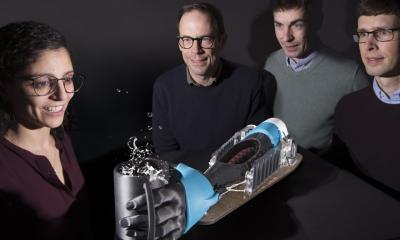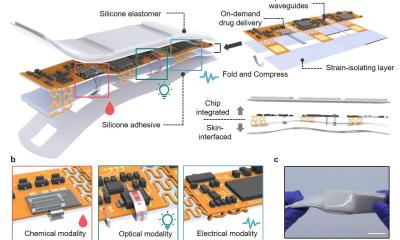Video • Wisdom tooth indeed
This electronic high-tech tooth could predict diseases
An interdisciplinary team of researchers from Washington University School of Medicine in St. Louis and the School of Engineering & Applied Science is redefining the notion of a wisdom tooth.
The team is developing a smart-tooth technology that could someday be used to detect early signs of certain diseases in high-risk patients by analyzing saliva or gingival crevicular fluid. “Salivary-based biosensors have generated a lot of interest because of their potential for wide applications in medicine,” said Erica Lynn Scheller, who trained as a dentist and is now an assistant professor of medicine and of cell biology and physiology in the School of Medicine. “We’re initially working to develop a biological sensor that measures specific peptides active in periodontal disease and that would be used in combination with a wireless device to retrieve that data.”
Really, anything you can think of that you’d want to track in the oral cavity, we’re developing both the platform and the specific application
Erica Lynn Scheller
“It’s like an electronic tooth,” said Shantanu Chakrabartty, professor of electrical & systems engineering in the School of Engineering & Applied Science and a partner on the project, currently funded by a four-year, $1.5 million grant from the National Institutes of Health.
That electronic tooth is actually a tiny sensor and an electronic chip, about a few millimeters-cube in volume. It is designed to be inserted inside the patient’s gum line or as part of a dental appliance, and contains bio-recognition elements that measure disease-specific peptides, which are natural or synthetic groups of amino acids. As a first attempt, the research team will work toward monitoring peptides related to bone breakdown during periodontitis, a dental disease that can lead to loosening and loss of teeth. A wireless ultrasound device would then be used to read the peptide levels and connect to the medical data-cloud.
Right now, one of the project’s biggest challenges is chemistry. “You only have a finite number of of bio-recognition elements conjugated to the transducer if you are using an antibody that is specific to these peptides,” said Srikanth Singamaneni, associate professor of mechanical engineering & materials science. “They get saturated fairly quickly. The question is how do you refresh those sensors? That’s one of the aspects we are working to address with this project.”
The research team says developing a new, minimally invasive system that can detect and monitor gum disease and the effectiveness of treatment would be beneficial to the 64 million U.S. residents with periodontal disease and to their dentists. The researchers also are interested in developing other applications for the technology that, while likely years away, could go well beyond the dentist’s chair. “We’re developing this sensing platform that can be expanded to include additional tracking for inflammatory markers, stress markers and diabetes monitoring,” Scheller said. “Really, anything you can think of that you’d want to track in the oral cavity, we’re developing both the platform and the specific application.”
Source: Washington University in St. Louis
19.04.2018










